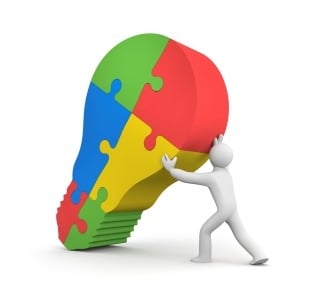Discover the Six Perceptual Styles™ and How They Shape Your World
To see a three minute presentation on a specific Perceptual Styleplease click on the specific image below
What is Perceptual Style™?
Perceptual Style is the way you take in information through your five senses and make that information meaningful to you.
It’s a fact. People truly do perceive the world differently, and this differing perception leads to different conclusions about what is important, how things should be done, and what is the “truth” of any situation.
The Perceptual Style Theory,created by Gary M. Jordan, PhD, and Lynda-Ross Vega, defines six unique Perceptual Styles.
Each Perceptual Style represents a grouping of fundamental aspects of being human that results in a distinctive perceptual experience and characteristic behaviors.
The more you know about your Perceptual Style, the more you can tap into your natural strengths and potential. That’s because there’s an extensive but finite set of skills and behaviors that naturally align with each Perceptual Style.
The alignment of skills and behaviors with Perceptual Style exists because people naturally see the things associated with their Perceptual Style. Those things are easy for them to grasp, understand, and use.
Awareness of the other five Perceptual Styles and how they differ from you provides incredible insights about your relationships with family and friends.
The truth is, what you see is real for you, but what others see is real for them. We all use the filter of perception to make meaning for ourselves.
All six Perceptual Styles are normal and healthy ways of perceiving the world. None is better than or more accurate in its perception than any other. Each has unique strengths and specific blind spots. All shine in some situations and struggle in others.
Here is a brief look at the six Perceptual Styles (presented in alphabetical order):
Activity Perceptual Style™
 People with the Activity Perceptual Style™ jump into life with both feet. They fully engage with the confidence that the details will sort themselves out. Direction, ideas, and pursuits emerge as the result of constant action and involvement with others and their surroundings. They engage until some new possibility or interest appears to capture their attention. They cultivate extensive networks of friends and associates.
People with the Activity Perceptual Style™ jump into life with both feet. They fully engage with the confidence that the details will sort themselves out. Direction, ideas, and pursuits emerge as the result of constant action and involvement with others and their surroundings. They engage until some new possibility or interest appears to capture their attention. They cultivate extensive networks of friends and associates.
Activity people develop an intense fascination with things that captivate their imagination, and they seek to share the excitement of their experience within their personal network. They are uninterested in things they find tedious or no longer hold their curiosity. They move rapidly from one experience to the next.
They draw on knowledge and previous experience from seemingly unrelated sources to create original and distinctive approaches and results. They find more enjoyment in activities that include members of their personal network. Positive response from their personal network is what drives them, and to that end, they pay attention to cultivating and sustaining that network.
Activity people bring energy and vitality to their actions and are often instrumental in getting things started. They believe that life should be fun as well as productive.
They get easily bored with repetitive and routine tasks and resist details and analysis. They are always ready to jump into something new, and they lose interest in activities that do not deliver attention-grabbing results. They quickly abandon anything they find boring and will wander off in search of other groups or activities that need energizing.
Activity people function best in settings that require interaction and allow them to get involved, share insight, tell stories, provide help, and communicate their perspective to others.
Adjustments Perceptual Style™
 People with the Adjustments Perceptual Style™ see the world as an objective reality that can be known if they take the time to gather complete information about its intricacies and complexities. They pursue the acquisition and application of knowledge as the basis for their life experience. They enjoy sharing their knowledge with others and gathering new information from research or conversation. They have a strong sense of diplomacy and project a calm certainty.
People with the Adjustments Perceptual Style™ see the world as an objective reality that can be known if they take the time to gather complete information about its intricacies and complexities. They pursue the acquisition and application of knowledge as the basis for their life experience. They enjoy sharing their knowledge with others and gathering new information from research or conversation. They have a strong sense of diplomacy and project a calm certainty.
The actions of Adjustments people reflect their skills in collating, analyzing, and sharing what they know in useful ways. They create intricate systems for the storage and retrieval of their knowledge.
The greatest satisfaction for Adjustments people comes from being an information resource for others rather than only applying the information themselves. As such, they are good at explaining and describing complex, detailed, or technical information.
Their thoroughness, patience with repetitive tasks, and desire for perfection allow them to spot where information is missing or fuzzy. They edit the written work of others effectively.
Adjustments people actively polish and hone their knowledge, their systems, and their processes to increase elegance and accuracy. They are at their best when given the time to do things carefully and systematically.
Time pressure, competition, and a drive for the bottom line all violate their view of the world. They believe these conditions lead to a false sense of urgency and impulsive actions that are based on incomplete understanding. They are intrigued by the exploration of ideas when the exploration is characterized by careful and comprehensive analysis that leads to steady evolutionary change.
Flow Perceptual Style™
 People with the Flow Perceptual Style™ are instinctive advocates for the natural rhythms of life. They see the complex connectivity among seemingly unrelated people, environments, and situations. They intuitively integrate and harmonize their actions within a broadly defined community that provides them and others with a sense of belonging. They honor the continuity between the past, present, and future.
People with the Flow Perceptual Style™ are instinctive advocates for the natural rhythms of life. They see the complex connectivity among seemingly unrelated people, environments, and situations. They intuitively integrate and harmonize their actions within a broadly defined community that provides them and others with a sense of belonging. They honor the continuity between the past, present, and future.
They create and sustain powerful but subtle relationships that form the glue of a community (family, friends, workgroups, social groups, etc.). They move smoothly and easily between daily events as their awareness emerges and recedes. They attend, in proper proportion, to events and people that require their attention, trusting that what needs to be done will be done.
Flow people facilitate the development of an environment that is comfortable, one that fosters and encourages people. When their environment shifts away from people-centered community, they quietly influence its realignment, putting their personal needs aside if necessary to bring it back into harmony.
Flow people welcome new events that support their traditions and values. They use relational communities to gather and transmit informal information after they have decided what to pass on and what to withhold. Their information sharing is so subtle that others experience the contribution Flow people make to create connections within the community but are often unaware of its source.
Flow people provide aid and assistance to the members of a community by serving as a listening post, encouraging development and growth, and empathizing with those who are struggling.
They are excellent administrators who interpret policy and procedure for their community. It is important to them that outsiders accurately perceive the value of the community. They are keepers of community history and tradition and provide continuity between the past, present, and future. They use the history of the community to keep it grounded.
Goals Perceptual Style™
 People with the Goals Perceptual Style™ stride through life focused on the accomplishment of specific results and well-defined objectives. They experience a sense of urgency and clarity of purpose. They believe achievement is primary and method or process secondary – the end justifies the means. They evaluate all activities based on possible contribution towards the achievement of the results they expect.
People with the Goals Perceptual Style™ stride through life focused on the accomplishment of specific results and well-defined objectives. They experience a sense of urgency and clarity of purpose. They believe achievement is primary and method or process secondary – the end justifies the means. They evaluate all activities based on possible contribution towards the achievement of the results they expect.
Goals people distrust complexity, subtlety, and solutions that evolve slowly over time. They believe that if a problem needs a solution, there is no time like the present to solve it.
They approach the world with focused energy and have a high level of endurance that allows them to push themselves well after others have given up. They take action with personal intensity and urgency, and they are always anxious to get on to the next task even before the current one is complete. What needs to be done next is obvious to them, so they do not understand why others around them do not see and act on it.
Goals people are very outcome-oriented and, as such, prefer to focus on the accomplishment of goals on which they can see immediate progress. They have no loyalty to current processes or methods and will abandon them quickly if progress toward a solution is slowing down and stagnating. They make high achievement demands on others but never more than they demand from themselves.
They approach life as a competition, and if they find no other worthy competitor, they will compete with themselves to see how far they can push themselves in terms of speed, quantity, and endurance.
Goals people are decisive in crises and adept at bringing structure out of chaotic situations. Their single-minded focus allows them to see the fundamental issues in problem situations, to determine the most important task, and to prioritize the steps necessary to accomplish their goal.
Methods Perceptual Style™
 People with the Methods Perceptual Style™ approach life in a practical, matter-of-fact manner. They focus on how things need to be done. They believe that ordered processes, properly followed, will produce the desired results. They will discern the best approach or technique to apply to any specific situation in order to deliver reliable, repeatable outcomes. They impose order, and they believe that everyone prefers to use well-known and proven methods.
People with the Methods Perceptual Style™ approach life in a practical, matter-of-fact manner. They focus on how things need to be done. They believe that ordered processes, properly followed, will produce the desired results. They will discern the best approach or technique to apply to any specific situation in order to deliver reliable, repeatable outcomes. They impose order, and they believe that everyone prefers to use well-known and proven methods.
Methods people follow an ordered set of steps that, when performed in a repeatable, logical sequence, inevitably end with the achievement of their objectives. They believe there is a correct method by which each problem, undertaking, or objective can be best handled. Discovering and applying this method is what drives them.
Once the desired result has been determined, Methods people do not question it. Instead, they seek to find the steps that will produce the desired outcome with the most efficient use of time, money, and energy. They believe that the failure of a solution to work is due to human error in the application of a correctly designed course of action.
Methods people analyze, manipulate, and apply facts. They use a rational application of empirical data to make decisions and solve problems, and they are confident that through this method, they will arrive at the correct conclusion.
They avoid becoming overly involved on a personal or emotional level and view both as distractions from the objectivity necessary to function effectively.
Methods people are matter-of-fact and consistent in high-pressure environments. Their ability to see structure and impose order allows them to help others function in the face of chaos and uncertainty.
Vision Perceptual Style™
 People with the Vision Perceptual Style™ approach life as a singular experience, a journey toward the future. They face the realities of a situation with serious intent, an optimistic perspective that a solution will be found, and confidence that if one is not, there are always other alternatives to explore.
People with the Vision Perceptual Style™ approach life as a singular experience, a journey toward the future. They face the realities of a situation with serious intent, an optimistic perspective that a solution will be found, and confidence that if one is not, there are always other alternatives to explore.
Vision people intuitively see new directions that others do not and make the most of this advantage by moving decisively. This ability to intuit new, useful directions and take swift advantage of opportunities as they arise gives them a strategic edge over others.
They are unafraid of taking risks and accept that the possibility of high rewards carries with it an equal possibility of failure. However, they view failure as only a temporary setback. They love to play with, explore, and develop new ideas, and they examine all aspects, possible outcomes, and consequences without preconceptions or judgment.
Vision people change direction when progress towards achievement of their vision is slow or blocked. As they move forward, they constantly tinker, experiment, and improvise with their actions in order to increase the likelihood of success. They are strongly committed to achieving their vision but are incredibly flexible about the path taken to get there.
They think non-linearly about problems, use their intuition, and try multiple possible solutions as they troubleshoot. When focused on an issue, they work it to the exclusion of all else, often until they are exhausted.
Vision people are highly persuasive and easily convince others that the current topic is most important. They enlist others to join them with equal excitement and commitment.
Vision people see multiple successful scenarios, and they coordinate complex information and activities so that all efforts lead toward success.

Frequently Asked Questions about Perceptual Style and Collaboration
What is Perceptual Style™?
Perceptual Style™ is the way you take in information through your five senses and make it meaningful. It shapes how you interpret events, make decisions, and connect with others — influencing everything from your communication to your leadership and relationships.
Why are there six Perceptual Styles?
There are six distinct Perceptual Styles because people naturally perceive and process information in different ways. Each style represents a unique pattern of strengths, blind spots, and preferred ways of interacting with the world.
What are the six Perceptual Styles?
The six styles are Activity, Adjustments, Flow, Goals, Methods, and Vision. Each one reflects a different way of perceiving reality and responding to life — from action-driven and pragmatic to analytical, people-centered, results-focused, methodical, or visionary.
How does understanding my Perceptual Style benefit me?
Knowing your Perceptual Style helps you recognize your natural strengths and how you best communicate, lead, and solve problems. It also helps you understand others’ perspectives, improving teamwork, relationships, and conflict resolution.
How do Perceptual Styles influence relationships?
our Perceptual Style affects what you notice, how you express yourself, and what you value in others. Understanding the six styles allows you to appreciate differences instead of misinterpreting them, which deepens trust and connection in relationships.
Is one Perceptual Style better than another?
No — all six Perceptual Styles are normal, healthy, and valuable. Each one shines in certain situations and has its own blind spots. Success comes from recognizing your natural way of seeing the world and appreciating the strengths of others.
How do I find out what my Perceptual Style is?
You can discover your unique Perceptual Style by taking the Perceptual Style™ Assessment, which provides personalized insights into how you see the world, your natural strengths, and ways to enhance your communication and relationships.
Can two people share the same Perceptual Style?
Yes — but no two people express it the same way. Your life experience shapes how your Perceptual Style shows up, meaning even if you share a style with someone, your strengths and blind spots will be uniquely yours.
How does Perceptual Style differ from personality tests like Myers-Briggs or DISC?
Unlike personality typologies that measure traits or behaviors, Perceptual Style focuses on how you perceive and interpret reality itself. It explains why you act, decide, and relate the way you do — offering deeper, more actionable self-awareness.
How can learning about the six styles improve my team or organization?
When team members understand each other’s Perceptual Styles, they can communicate more effectively, assign tasks that match natural strengths, and resolve conflicts more productively — creating a more adaptable and collaborative workplace.






